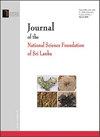斯里兰卡黄鳍金枪鱼出口行业供应链选定阶段组胺形成细菌的流行、分离和鉴定
IF 0.4
4区 综合性期刊
Q4 MULTIDISCIPLINARY SCIENCES
Journal of the National Science Foundation of Sri Lanka
Pub Date : 2023-06-30
DOI:10.4038/jnsfsr.v51i2.10819
引用次数: 0
摘要
本研究旨在确定组胺形成细菌(HFB)及其引入来源,以建议控制措施,减轻黄鳍金枪鱼(YFT)中组胺的形成。从Dikkowita、Negombo、Trincomalee和Dondra渔港登陆的多日船上采集了现场样本。收集来自鱼舱(n=63)和冷藏运输车(n=63。从鱼类加工厂采集鱼腰样本(n=15)、冰样本(n=36)和YFT(n=18)、地板(n=18。从Nivens培养基和紫红色胆汁葡萄糖(VRBG)琼脂中分离的假定HFB在添加1.0%L-组氨酸的Tripticase大豆肉汤(TSB)中筛选组胺形成能力。通过对大约1400bp的16S rDNA进行测序来表征HFB分离株。从冰样本中分离出的TSB中产生3000–4000 ppm组胺的7个分离株和从甲板上采集的一个拭子样本分别被确认为产气克雷伯菌(n=6)和摩根氏菌(n=1)。Hafnia alwei(n=1)、Serratia sp.(n=2)、Citrobacter freundii(n=1。假单胞菌(Pseudomonas sp.,n=24)和巴氏谢瓦内拉(Shewanella baltica,n=7)也被分离出来,它们被称为腐败细菌,并显示出弱组胺形成。因此,很明显,形成组胺的细菌可以从冰和接触表面引入鱼类。这就需要严格的清洁程序和适当的采后处理程序,以最大限度地减少对鱼类的污染。本文章由计算机程序翻译,如有差异,请以英文原文为准。
Prevalence, isolation and identification of histamine forming bacteria in selected stages of supply chain of Yellowfin tuna export industry in Sri Lanka
This study aimed to identify histamine-forming bacteria (HFB) and the sources of introduction of such bacteria to recommend control measures to mitigate histamine formation in yellowfin tuna (YFT). Field samples were collected from multi-day boats that landed at Dikkowita, Negombo, Trincomalee and Dondra fishery harbours. Ice from the fish holds (n=63) and chill transport vehicles (n=63), and swabs from the fish holds (n=63), the boat decks (n=63) and the skin of YFT (n=63) were collected. Fish loin samples (n=15), ice samples (n=36) and swabs from the skin of YFT (n=18), floor (n=18) and chill transport vehicles (n=18) were collected from fish processing plants. Presumptive HFB isolated from Nivens medium and Violet Red Bile Glucose (VRBG) agar were screened for histamine forming ability in Tripticase soy broth (TSB) supplemented with 1.0% L-histidine. HFB isolates were characterized by sequencing approximately 1400 bp of the 16S rDNA. Seven isolates that produced histamine in the range of 3000–4000 ppm in TSB isolated from ice samples, and a swab sample collected from the boat deck, were confirmed as Klebsiella aerogens (n=6) and Morganella morganii (n=1) respectively. Hafnia alvei (n=1), Serratia sp. (n=2), Citrobacter freundii (n=1), Rahnella sp. (n=1) and Aeromonas salmonicida (n=8) were also among the isolated histamine forming bacteria. Pseudomonas sp. (n=24) and Shewanella baltica (n=7), which are known as spoilage bacteria were also isolated and showed weak histamine formation. Hence, it is evident that histamineforming bacteria could be introduced into the fish from ice and contacting surfaces. This necessitates the practice of rigorous cleaning procedures and adaptation of proper postharvest handling procedures to minimize contamination of the fish.
求助全文
通过发布文献求助,成功后即可免费获取论文全文。
去求助
来源期刊

Journal of the National Science Foundation of Sri Lanka
MULTIDISCIPLINARY SCIENCES-
CiteScore
0.90
自引率
0.00%
发文量
57
审稿时长
>12 weeks
期刊介绍:
The Journal of National Science Foundation of Sri Lanka (JNSF) publishes the results of research in Science and Technology. The journal is released four times a year, in March, June, September and December. This journal contains Research Articles, Reviews, Research Communications and Correspondences.
Manuscripts submitted to the journal are accepted on the understanding that they will be reviewed prior to acceptance and that they have not been submitted for publication elsewhere.
 求助内容:
求助内容: 应助结果提醒方式:
应助结果提醒方式:


